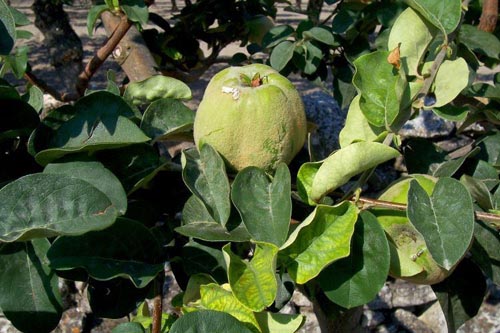Relatives
Cydonia oblonga Mill. - Quince, common quince.
Taxonomic position.
Family Rosaceae Juss., genus Cydonia Mill.Synonyms.
Pyrus cydonia L., Cydonia cydonia Pers., C.vulgaris Pers.Morphology and biology.
Species is a deciduous tree or shrub that grows up to 1.5-5 m tall. The stem is covered with thin, scaly bark. Young shoots are wooly tomentose, but later become bare. Leaves are 10(12) cm long and 7.5 cm wide, ovate or oval, smooth-jagged edged, acute or obtuse at the top, with a short cusp on the tip, dark green, bare from above and grayish tomentose from below; young ones are cobwebby tomentose from above. Stipules are adenodentate. Flowers are solitary, pale pink, up to 5 cm in diameter, set on short pedicels. Pedicels, receptacle and outer side of sepals are covered with tomentose pubescence. Sepals are oval, adenoserrate along the edge. Fruits are 2.5-3.5 cm in diameter, tomentose in the beginning and bare when mature, lemon-yellow or dark yellow, for the most part slightly costate, round or pear-shaped; their pulp is not juicy, with numerous sclereids, astringently sweet in taste, very fragrant. Entomophilous. Zoochore. Blossoms in April-May; bears fruit in October-November. 2n = 34.Distribution.
Distributed in the Caucasus (Western and Eastern Ante-Caucasus, Daghestan, Eastern and Southern Transcaucasia, Talysh) and Central Asia (Kopetdagh - the ravine of Aydere). The distribution of wild-growing quince in other areas of Central Asia has not been proven. It also grows in Iran, Turkey, Afghanistan and Pakistan. The species became widespread, due to cultivated forms, and naturalized over almost the entire Mediterranean region.Ecology.
Mesoxerophyte. Photophilous. Grows in the underbrush of downstream liana forests; in oak groves with hornbeam; on forest edges and glades; in the thickets of xerophilous shrubs on dry, frequently carbonate soils; and in alluvial soils of river valleys, where it survives temporary floods. In the mountains, it grows as high as the middle mountain zone.Utilization and economic value.
It is used for food and as an ornamental plant. Fruit are most often consumed when boiled or baked, as a dressing to meals, or used to prepare jelly, jam, marmalade, syrup and drinks. Quince is considered one of the best frost-resistant stocks for the pear tree. Species shows promise for hybridization. Endures clipping quite well and is suitable for green hedges.Reference citations:
Brezhnev D.D., Korovina O.N. 1981. Wild relatives of cultivated plants in the flora of the USSR. Leningrad: Kolos. 166 pp. (In Russian)Poyarkova, A.I. 1939. Quince-Cydonia Mill. Flora of the USSR. V. 9. Moscow-Leningrad: Publishing House of the USSR Academy of Sciences. 334-335 pp. (In Russian)
Sokolov S.I., Svjaseva O.A., Kubli V.A. 1980. Areas of distribution of trees and shrubs in the USSR. V. 2. Leningrad: Nauka. 54 p. (In Russian)


